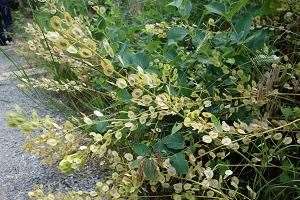Field Guide  Weed Management
Weed Management  Stinkweed
Stinkweed
Stinkweed (Thlaspi arvense L.)
Crop Impacts: Canola, dry beans, corn, potatoes and soybean fields
 | |
About Stinkweed:Stinkweed, also commonly known as Field Pennycress, is an annual and winter annual plant that reproduces through the release of its seeds. It produces a sour turnip-garlic like smell, and when consumed by dairy cattle can taint the milk they produce. Each plant can produce up to 15,000 seeds, which typically germinate between mid-April to mid-May and again in late summer. Seedlings over the winter and in the spring continue to grow. Family: Mustard Family (Cruciferae)  
Stinkweed Scouting and Prevention:The stem of a Stinkweed plant can be 5 to 60 cm tall, with branching occurring at the top of the plant. The first sets of leaves have smoothed or slightly wavy edges that lay just above the soil surface on the ground. The leaves that sit at the bottom part of the stem have shallow, irregular teeth that are narrow at the stalk and rounded toward the tip. The middle to upper leaves can be shallow, or deeply toothed with a pairs of lobes that sit at the bottom which holds onto the stem. Stinkweed produces very small white flowers that sit at the ends of their branches in rounded clusters. Common locations- - Cultivated fields
- - Gardens
- - Canola fields
- - Dry beans fields
- - Corn fields
- - Potatoes fields
- - Soybeans fields
Stinkweed Control:Cultural ControlThe best way to eliminate Stinkweed is to cultivate the fields that are infested during the fall. Plants that have germinated in late summer or fall are extremely difficult to get rid of the next spring. Chemical ControlTaking control of Stinkweed in the fall when the plant is still weak and venerable is the most effective. The translocation and environmental conditions during this season makes the application of 2,4-D or MCPA to your crops have a much more consistent application. Latin / Alternative Stinkweed names:- - Thlaspi arvense L.
- - Field Pennycress
- - Frenchweed
- - Fanwwed
Additional Stinkweed Resources |
http://www.agric.gov.ab.ca/app107/loadPest?action=display&id=103
http://www.cropscience.bayer.ca/Pest-Finder/Weeds/Broadleaf/Stinkweed.aspx#accordion_2